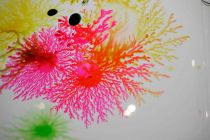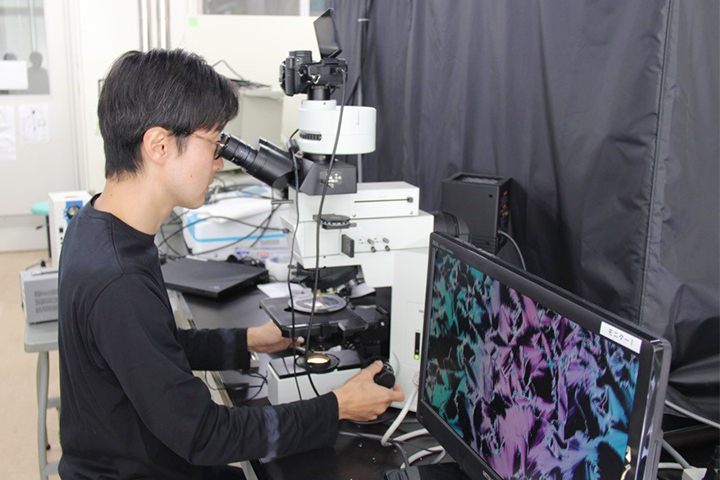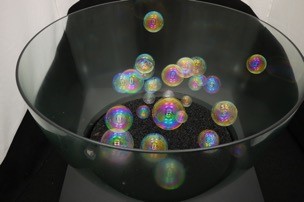TSUKUBA FUTURE
#113 The Beautiful World of Soft Matter
Assistant Professor HISHIDA Mafumi, Faculty of Pure and Applied Sciences

When oil is added to water, the drops of oil clump together to avoid the water. Everyone is familiar with this phenomenon, but we actually do not yet fully understand what kinds of interactions take place between the two. The structures of surfactants and cell membranes of living things are also determined by interactions with water, but the mechanisms that produce these structures have not been fully uncovered. Prof. Hishida's research is focused on these kinds of soft materials, specifically lipid membranes, and the mechanisms by which they take on various forms in water.

Lipids are a basic structural element of cell membranes. They form a bilayer structure consisting of one part that interacts well with water and one that does not. The part that does not interact well with water faces inward, and the bag-like structure is the cell. Cellular components such as the nucleus and DNA are contained inside that structure. It is said that about 60% of the human body is made up of water, so it would not be possible to form a human body if the layers of the cell membrane were reversed. However, even though the physical and chemical properties and functions of lipids themselves have been studied, the mechanisms by which lipids naturally form the structures of membranes and cells when in water (self-organization) are poorly understood. Prof. Hishida is researching the mechanisms of self-organization of soft materials such as lipids, surfactants, and polymers. Recently, he has been focusing on uncovering the role of water as a solvent. This is also closely related to the question of why water is necessary for life.
The "soft" in the term soft matter means that the connections between molecules are weak. Even in lipid membranes, molecules are not directly bonded together, but rather lined up in an orderly fashion to avoid water. In spite of this, they actually function as a very strong membrane. It is strange that the molecules can exert such strength just by the presence of water. Water, though a simple and mundane substance, must be playing some kind of critical role. However, it is actually very difficult to directly observe the behavior of water molecules, and research techniques are limited. Due to these barriers, few researchers undertake the challenge. Prof. Hishida uses a special technique called Terahertz spectroscopy to capture the micro-movements of individual water molecules and determine how they interact with lipid membranes and other structures dissolved in the water.

Prof. Hishida never gets tired of looking at the wondrous structures and movements of soft materials
Spectroscopy is a technique for determining the physical properties of a substance by shining light on the substance and analyzing how the substance absorbs that light. Various different kinds (wavelengths) of light are used depending on the characteristics of the substance or the properties being evaluated. Terahertz spectroscopy uses Terahertz waves, which are electromagnetic waves whose wavelength is in the far-infrared region of the spectrum. However, this technique only provides vague data with poorly defined peaks. Therefore, it is necessary to apply various theories to the data to break down the components of the peaks. Researchers have to personally develop computer programs or custom instrument settings to do this. These kinds of analytical techniques are Prof. Hishida's specialty, and let him show off his skills.
He uses various other techniques besides spectroscopy in his research. He can also directly observe the shape and softness of membranes using a microscope, and he sometimes examines nanometer-scale structures using X-rays or neutron beams, or looks at changes in structure caused by temperature changes. He analyzes these kinds of data comprehensively to determine what is happening between membranes and water. Soft materials with a similar chemical structure can take on completely different properties (for example, strength or absorbency) in different surrounding environments. The softness of these materials is what causes their structures and properties to change in complex ways.
When observed under a microscope, membranes exhibit fantastically beautiful colors and shapes, and change rapidly when exposed to just a small amount of heat or another such stimulus. Prof. Hishida says that they are so beautiful he could stare at them forever. To express their beauty outside of his research, he also creates works of art such as movies and installations, sometimes working by himself, and sometimes on a team with artists or engineers. He first entered a competition at an art festival a few years ago, and has since shown his work at art festivals and exhibitions across Japan. He cannot easily use the reagents and other materials he would normally use in his laboratory in these exhibitions, and must painstakingly determine how to express his vision with limited materials and space. Even with these limitations, he gets surprising reactions from viewers of his art who come from fields he wouldn't normally encounter in the course of his research. These reactions prompt new discoveries that he applies back to his research.

"Interfering Floating Bodies" exhibited at KENPOKU ART 2016
Soap bubbles are also membranes. Prof. Hishida designed them so that they would float in the air and allow viewers to stare at their beautiful colors (structural colors)
Prof. Hishida is skilled at research that involves conducting many different experiments and piecing a variety of data together to understand a single subject. He wants to make use of not only his laboratory equipment, but also a variety of experimental techniques, to understand the true nature of membranes and water. His primary motivation is simple: He wants to understand the beautiful and fascinating structures formed by soft materials and how those structures are formed, without narrowing his focus to any particular substance or function. His interests extend from his main focus of membranes to many different fields, including physics, chemistry, biology and art.
Article by Science Communicator at the Office of Public Relations


